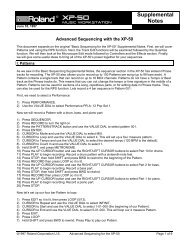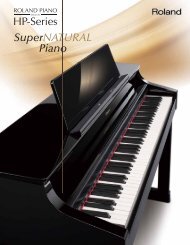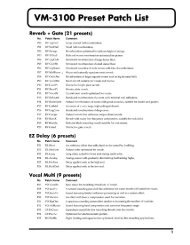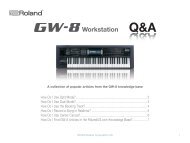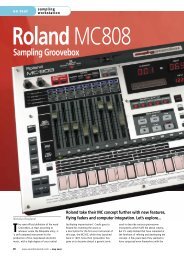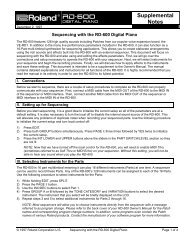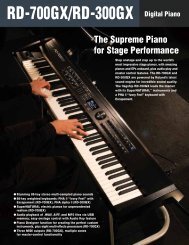You also want an ePaper? Increase the reach of your titles
YUMPU automatically turns print PDFs into web optimized ePapers that Google loves.
Patch editing parametersLFOLFO (Low Frequency Oscillator) creates cyclic changes. Each tone has two LFOs, and these can be used to apply change to pitch, filtercutoff frequency, amp level, and pan.Using the LFOsAn LFO applied to pitch creates vibrato, applied to filter cutoff frequency creates a wah effect, and applied to amp level creates tremolo. WhenLFO is applied to pan, a distinctive auto-pan effect is produced.LFO settings can also be used to do things such as cyclically exchanging two tones. For example, to cyclically exchange tones 1 and 2, specify thesame LFO effect for each, and set the LFO depth to opposite polarities (+/-) for the amp level.* The parameters of LFO 1 and 2 are the same.<strong>Parameter</strong> Value DescriptionLFO1(2) Waveform SIN, TRI,SAWU,SAWD,SQR, RND,BD-U,BD-D, TRP,S&H, CHS,XSIN,TWM, STRS,VSIN,M001–M113LFO waveformSIN: sine wave TRI: triangle wave SAWU: sawtooth wave SAW-D: sawtooth wave (inverted)SQR: square wave RND: random waveBD-U: a waveform that lets the LFO output waveform rise to the reference level and holds it thereBD-D: a waveform that lets the LFO output waveform fall to the reference level and holds it thereTRP: trapezoidal wave S&H: sample and hold wave (LFO value will change once each period)CHS: chaos waveXSIN: sine wave that reverses between positive and negative at an extremely short intervalTWM: modified triangle wave STRS: stair-step wave VSIN: modified sine wave suitable for vibratoM001–M113: the waveform will change continuously from a sine wave to sample & hold* If you select “BD-U” or “BD-D,” set the Key Trigger (p. 51) parameter to “ON.” There will be no effectif you set it to “OFF.”LFO1(2) Rate 0–127, note Speed of the LFO cycleOffset(LFO Offset)Rate Detune(LFO Rate Detune)Delay Time(LFO Delay Time)Delay Time KF(LFO Delay Keyfollow)* The chaos waveform has no cycle. If you select the chaos waveform, the rate setting will be ignored.-100– +100 Offset level of the LFO waveformAdjusts the waveform upward or downward.0–127 Amount by which the LFO rate will be changed0–127 Time from when you press (or release) a pad until the LFO amplitude begins to change-100– +100 Amount by which the Delay Time will be affected by the pad you pressModifies the Delay Time parameter according to the pad you press, relative to C4 (middle C). Specifya positive (+) value if you want the LFO effect to be applied more quickly as you press higher notes,or specify a negative (-) value if you want a greater delay to occur before the effect is applied. Highersettings will produce a correspondingly greater change.Time-100-500+50+100C1 C2 C3 C4 C5 C6 C7KeyFade Mode(LFO Fade Mode)Fade Time(LFO Fade Time)Key Trigger(LFO Key Trigger)On,OffHow the LFO effect is appliedOn< (ON-IN): The effect will be applied gradually after you press the pad.On> (ON-OUT): The effect will be applied when you press the pad, and will gradually disappear.Off< (OFF-IN): The effect will be applied gradually after you release the pad.Off> (OFF-OUT): The effect will be applied as long as you hold down the pad, and will graduallydisappear when you release the pad.0–127 Rise (or decay) time for the LFO effectOFF, ONSelection for whether the beginning of the LFO cycle will be aligned to the timing at which you press apad (ON), or will not be aligned (OFF)51




